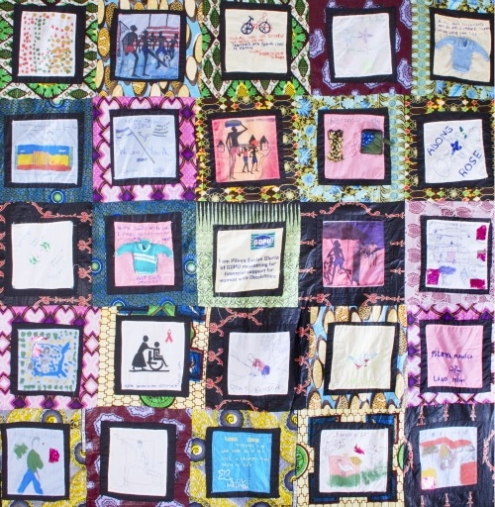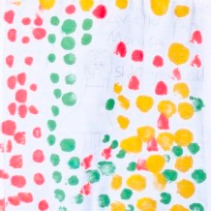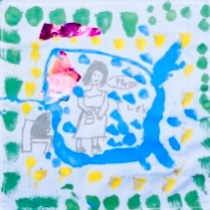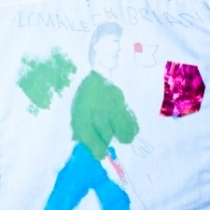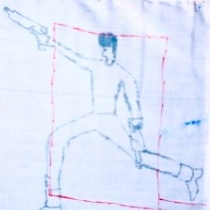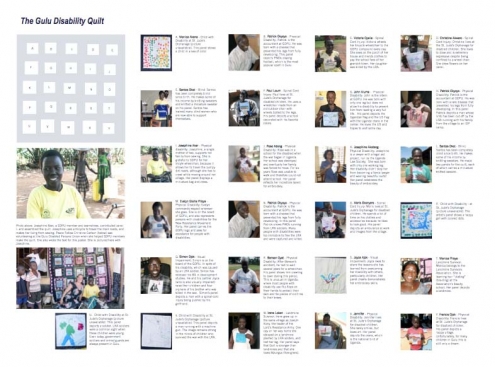The Gulu Disability Quilt
Background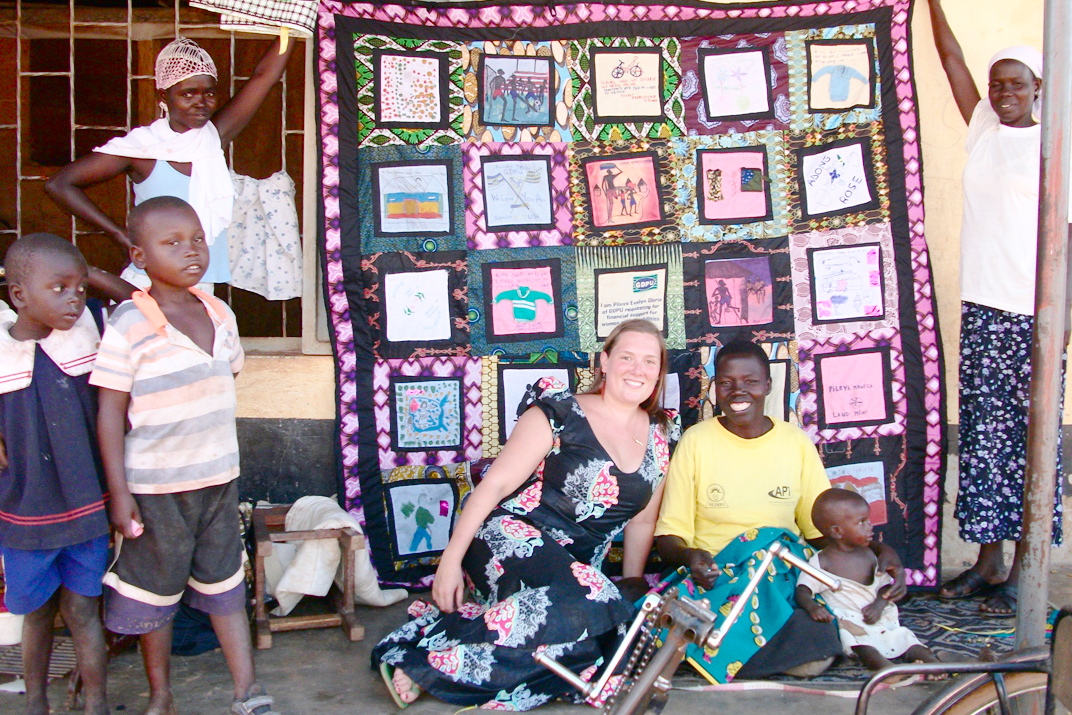 Peace Fellow Christine Carlson coordinated the making of the Gulu Disability Quilt during her fellowship at the GDPU in 2010. Josephine Aker, right, assembled the quilt and contribute one square. The Gulu Disability Quilt depicts the crisis of disability that erupted in northern Uganda following the rebellion of the Lord’s Resistance Army (LRA). The violence left thousands of Ugandans disabled by landmines, disease, neglect and forcible displacement and internment. For more background visit the partner page of the Gulu Disabled Persons Union (GDPU). In the summer of 2010, Peace Fellow Christine Carlson, who was working at GDPU, asked GDPU members if they would like to tell their stories through embroidery. Like other Fellows that summer, Christine showed photos of the Srebrenica and Guatemala memorial quilts. GDPU reacted with enthusiasm and within a month the group had produced no fewer than 25 lively squares. These offer a remarkable portrait of the Ugandan war, from the perspective of those most affected. One of the artists, Okoyo Patrick, is the accountant at GDPU. Patrick was born with a disease that prevented his legs from fully developing. He well remembers what it was like to be displaced during the war, and his tile shows people with disability running from LRA rebels. Given the immobility that comes with disability, many were chased down and killed. In a second tile, Patrick depicts a man whose limb has been cut off by the LRA running with his family from the village to an IDP camp. However somber the content, many of the squares are quirky and clever. Okot Santos (photo) has been completely blind since birth. He earns a living by knitting sweaters, and produced a miniature sweater on his wife’s sewing machine, which he attached to a panel. 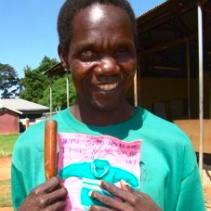 Santos Okot was of twenty GDPU members who made squares for the Gulu Disability Quilt. Most squares depict the crisis of disability caused by the LRA rebellion. As with other advocacy quilts, the panel-making turned into a communal event. Most of the artists were male, but women also participated (photo) and they all became close friends in the process: “The project helped us to realize that we could work together to produce something beautiful,” said GDPU board member, Caroline Rose Adong. Unlike other advocacy quilts, which were assembled in the US, the Gulu Disability Quilt was put together in Gulu by Josephine Aker an experienced quilter. Josephine also contributed two panels to the quilt. She makes a living from sewing and quilting, and uses a tricycle to travel the main roads. Moving around within her village, where the roads are poor, is a lot harder. The Gulu Disability Quilt was first displayed in the spring of 2011 at the headquarters of the Gates Foundation in Seattle. Lisa Balleaux, from the Foundation, had financed Christine’s fellowship and Lisa’s donation was matched by the Foundation. The quilt hung in the cafeteria for several weeks, before being shipped to AP in Washington. It was next shown at the Kean University exhibition, where its intricate stories proved fascinating for students. For GDPU, the idea had definitely caught on. In 2012, GDPU members made more squares for a second quilt. These were entrusted to 2012 Peace Fellow Dane Macri and are awaiting assembly into a second quilt. |
Artists
Artists
|
Paul LoumPaul Loum lives at St. Jude’s Orphanage for disabled children. He uses a wheelchair made from an old outdoor chair with wheels bolted to the legs. He loves it when the able-bodied children wheel him around the compound. They love him, so they wheel him around often. His panel depicts a school decorated with his favorite colors. |
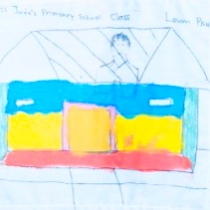 |
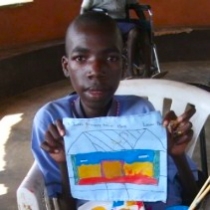 |
Josephine AkotangJosephine Akotang is a lawyer with Legal Aid Project, Uganda Law Society. She was born with only one working leg. Her disability didn’t stop her from becoming a fierce lawyer or wearing beautiful suits everyday! She works at GDPU defending the rights of PWDs. Much of her work pertains to defending the land rights of PWDs. During the war many people were required to live in IDP camps. When they returned to their village they would find another family living there. She also works for the right of PWDs to work. Her panel exhibits her beautiful embroidery. |
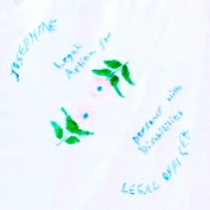 |
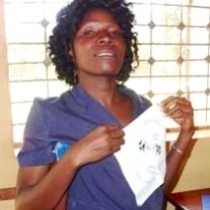 |
Patrick OkoyaPatrick is the accountant at GDPU. He was born with a disease that prevented his legs from fully developing. This did not prevent him from having a family of three and a good career. He has many harrowing stories about moving to IDP camps every night during the war. In his three panels Patrick depicts a man whose limb has been cut off by the LRA running with his family from the village to an IDP camp; PWDs playing football, as much of life in Gulu surrounds the game; and PWDs running from LRA Soldiers. This flight was particularly difficult for persons with mobility issues and many were captured and killed. |
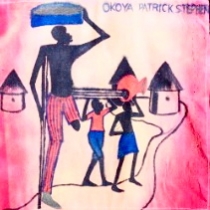 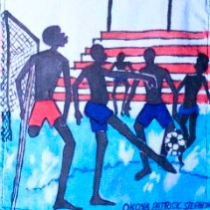 |
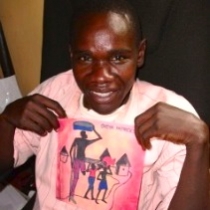 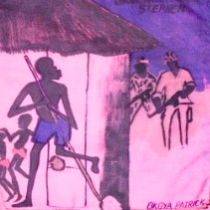 |
John AlumaJohn Aluma is the intern at GDPU. He was born with only one leg but does not allow his disability to prevent him from leading a very full life. He attended university and loves his family and girlfriend very much. His panel depicts the Ugandan flag and the US flag with the Uganda crane in the center. He loves the US and hopes to visit some day. |
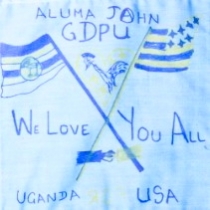 |
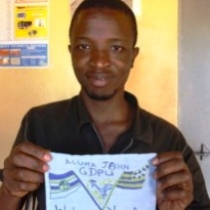 |
Santos OkotSantos Okot has been completely blind since birth. He makes some of his income by knitting sweaters. He has trained many blind women who support themselves with the skill he taught them. Everyday he walks several miles without assistance around Gulu. People often help him and many motor cycle taxis know him by name. He is always smiling and holding his friends’ hands. For his first panel, he knitted a miniature sweater on his knitting machine. For his second panel he knitted a miniature sweater on his knitting machine for his wife. |
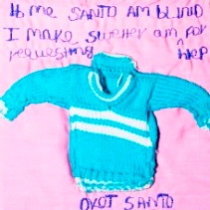 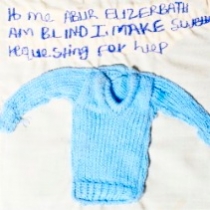 |
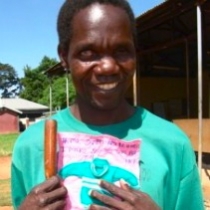  |
Simon OjokSimon is on the board of the Gulu Disabled Persons Union. He is visually impaired from having been beaten by an LRA soldier. In spite of his disability, he has received his Bachelors degree in Development Studies from Makerere University in Kampala. “I myself started being independent from P1 up to university. Other people should also be independent, economically and politically. They should be made free. This can only happen if they unite and focus.” Simon says. “The best way to help a person is to make this person help himself. It is important to give some guidance here.” Simon and his partner Joyce, who is also visually impaired, raise their two children and the four orphans of Simjon’s brother, who was killed in the war. Simon’s panel depicts a man with a spinal-cord injury being pushed by his girlfriend. |
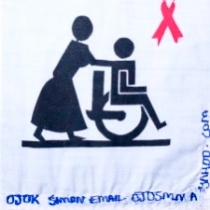 |
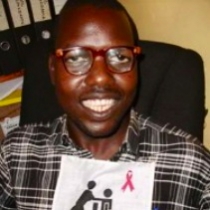 |
Victoria OyellaVictoria Oyella wheels her tricycle wheelchair to the GDPU compound every day. She sits on the porch with her sewing machine making and fixing garments so that she can pay the school fees of her grandchildren. Her daughter was killed by the LRA. Victoria embroidered her tricycle wheelchair and a message asking for assistance on her panel. |
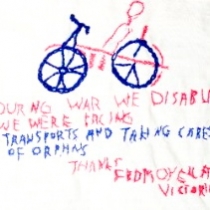 |
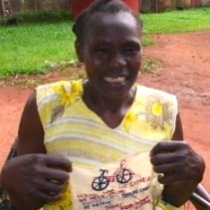 |
Evelyn Gloria PiloyaEvelyn Gloria Piloya is a well known and loved member of the community. She is on the board of GDPU, and also represents persons with disabilities for the New Resistance Movement Party, the party of President Museveni. Whether she is in a board meeting or political meeting she doesn’t let her disability, her small stature or the fact that she is a woman stop her from expressing strong opinions. She commands respect everywhere she goes. She is always incredibly kind and displays the grace that is particular to Acholi women. It is amazing to see her throw her crutches to the side and climb on the back of a “boda,” or motorcycle taxi. Her panel shows the GDPU logo and ask for assistance. |
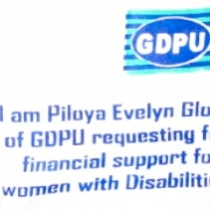 |
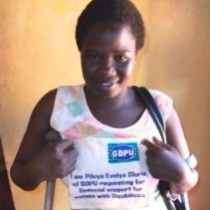 |
Benson OyatAfter Benson Oyat’s accident, he had to wait several years for a wheelchair. He was forced to crawl from his village to the town of Gulu when he needed food or other necessities. He is very grateful to GDPU for his wheelchair and often visits the compound. His panel depicts himself crawling to town. This is a common sight in Uganda. People with disability often use flip-flops on their hands to protect their skin. They also tie pieces of old tires to their knees |
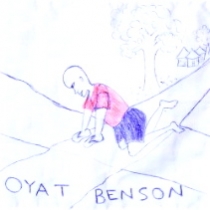 |
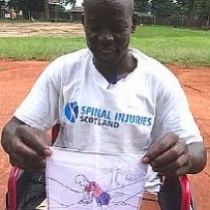 |
Irene LakerIrene grew up in the same village as Joseph Kony, the leader of the LRA. One day on her way home she stepped on a landmine that his army had planted and lost her leg. She lived without hope for several years until an Italian organization (The Association of Volunteers in International Service – AVSI) gave her a new leg and support. Now Irene takes classes at the Landmine Survivors Beauty School, located in the GDPU compound. All day she and the other students learn to “plate,” or braid hair. She always has smile on her face and says she has a special place in her heart for “mzungus” (white people). Her panel says that God is stronger than landmines and that she loves Mzungus. |
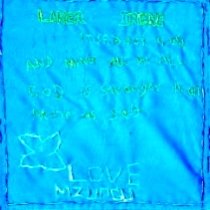 |
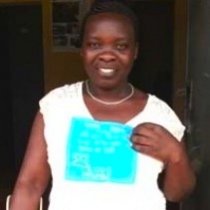 |
Christine AkweroChristine Akwero lives at St. Jude’s Orphanage for disabled children. She loves to draw and is extremely expressive despite being confined to a wheel chair. Christine suffers from such extreme bed sores that she must lay on a bed with wheels or mat all day. She drew flowers on her panel. |
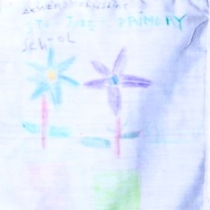 |
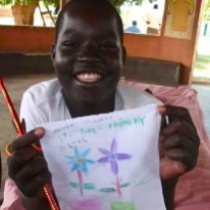 |
Josephine Akumu
|
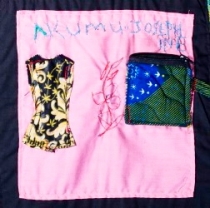 |
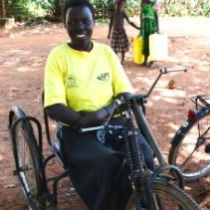 |
Joyce AjokJoyce Ajok shares what she has learned from overcoming her visual impairment. She also seeks to teach children how to overcome their own disabilities. Her panel shows off her embroidery skills. |
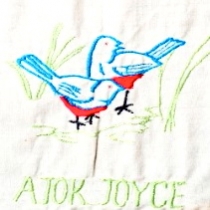 |
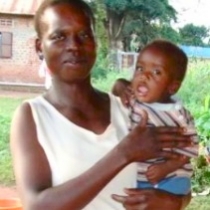 |
JenniferJennifer lives at St. Jude’s Orphanage for disabled children. She rarely smiles, but loves to make artwork. Her panel depicts the Crane, the bird of Uganda. |
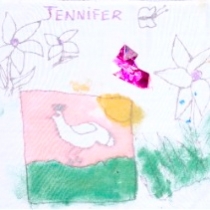 |
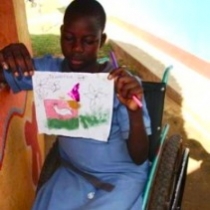 |
Rose AdongRose Adong was in a school for the disabled when the war began in Uganda. Her school was destroyed and eventually her family was forced to move. For six years Rose was unable to walk and therefore could not attend school. The only way Rose was able to move around was through crawling, and this was restricted to her home. The war was intense during this time, and her parents were unable to adequately care for her. In 1992, when she was sixteen, she had an operation that enabled her to return to school after spending a year recovering in the hospital. Rose had to be taught how to walk again. Her panel shows off her incredible embroidery talents. |
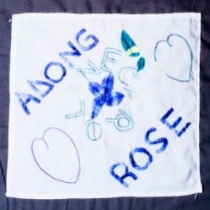 |
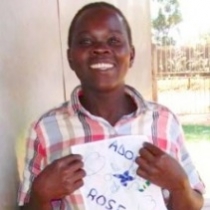 |
Moris OkonyeroMoris Okonyero lives at St. Jude’s Orphanage for disabled children. He spends time selecting his clothes and accessories because he likes to look good. His creative panel depicts an ambulance that would have been used during the war, as well as love and images from the village. |
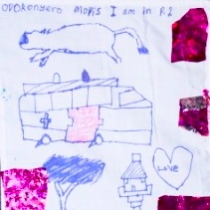 |
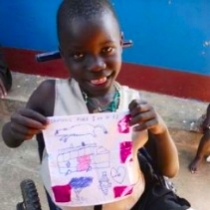 |
Monica PiloyaMonica Piloya belongs to the Landmine Survivors Association. She is learning hair “plating,” or braiding at the Association’s beauty school. Her panel depicts a landmine. |
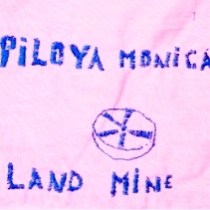 |
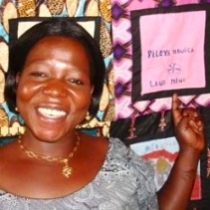 |
Francis OjokFrancis Ojok lives at St. Jude’s Orphanage for disabled children. His panel depicts a happy village. For many children in Gulu this is only a dream. |
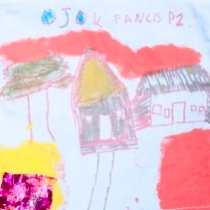 |
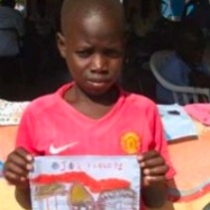 |
| Quilt photos by Brian Gohacki Artist photos and interviews by Christine Marie Carlson |

